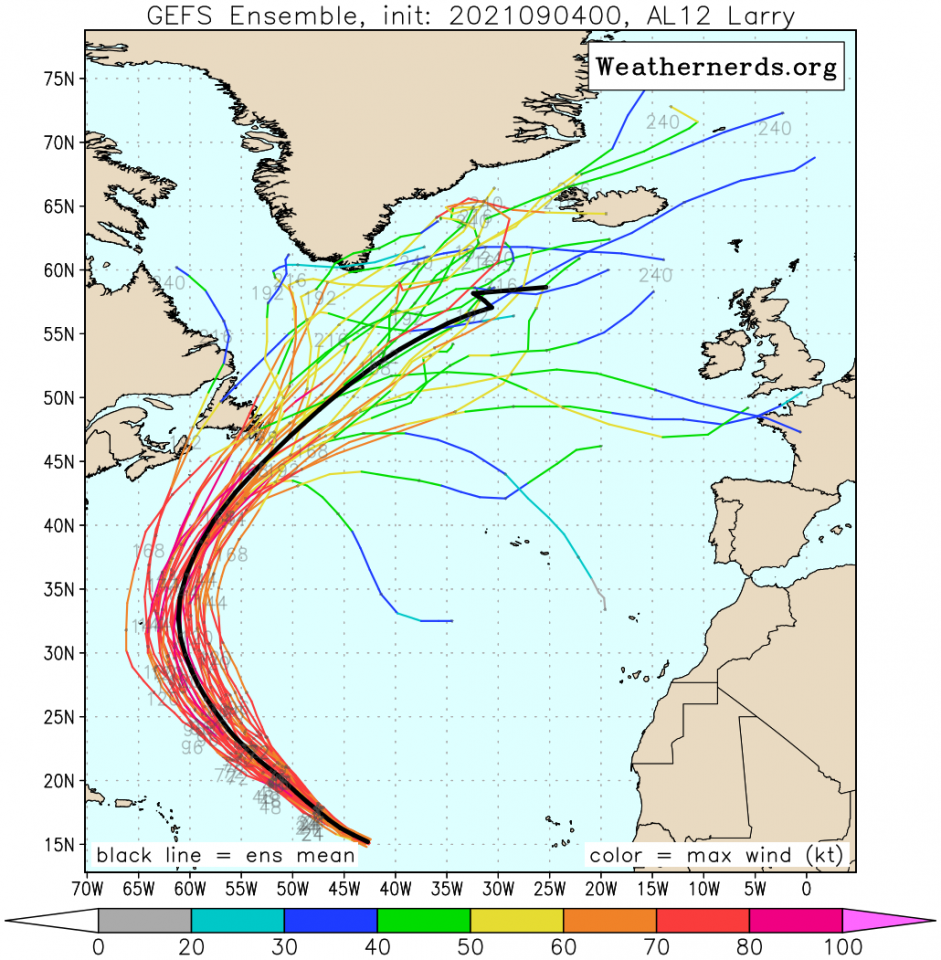Arktos schrieb:Das ist jetzt bisschen abgefahren, aber könnte es irgendwann möglich sein, dass es ein Hurrikan über Südspanien ins Mittelmeer schafft? Durch das warme Wasser würde er dann nochmal sehr an Stärke gewinnen.
Grüß Dich Arktos!
Meiner Meinung nach wäre das nicht möglich. Er wäre ja ohnehin schon außertropisch, wenn er auf Spanien treffen würde, dann wäre es auch ein Landgang und damit eine massive Abschwächung, da die Energie verloren geht. So bliebe maximal ein Sturmtief über, dass theoretisch das Mittelmeer erreichen würde. Aber das Mittelmeer ist nicht viel mehr als eine Badewanne. Nur an einer Stelle - etwa bei Sizilien - können sich hurricane-ähnliche Sturmtiefs entwickeln, aber wegen der fehlenden Ozeanfläche nur kleinere Exemplare.
Zu "Larry":
gestern wurde der Hurricane zum Major-Hurricane hochgestuft, er hat 115 mph Windgeschwindigkeiten erreicht, was etwa 185 km/h entspricht. Das Auge ist schon gut ausgebildet. Der Umfang des Systems wächst weiter. Die meisten Modellberechnungen sehen eine weitere Verstärkung auf KAT 4, einige wenige sogar KAT 5. Hier mal die verschiedenen Modelllösungen zu den Windstärken von Larry in den nächsten Tagen:
 12L_intensity_04.09.2021.png
12L_intensity_04.09.2021.png (Größe: 32,52 KB / Downloads: 207)
Quelle: Link ist nur fuer registrierte User sichtbar.
registrieren oder
login.
Das NHC beschreibt die Lage und die Aussichten heute so, ich setzte mal den ganzen Text ein, da es spannend ist, das später auch noch mal zu lesen. Quelle: Link ist nur fuer registrierte User sichtbar.
registrieren oder
login.
Zitat:Hurricane Larry Discussion Number 14
NWS National Hurricane Center Miami FL AL122021
1100 PM AST Fri Sep 03 2021
Larry has had a distinct but slightly ragged 15 n mi wide eye
during the past few hours, while convective cloud tops within the
eyewall have been gradually cooling. Intensity estimates have
responded, somewhat significantly, to the improved structure, and
TAFB and SAB Dvorak fixes at 0000 UTC were T5.5/102 kt and T5.0/90
kt, respectively. In addition, objective UW-CIMSS ADT and SATCON
estimates are near 105 kt. Larry has become a major hurricane, the
third of the Atlantic season, with estimated 100-kt sustained winds.
The hurricane is located due south of a mid-tropospheric high
centered over the central Atlantic, and continues to move toward
the west-northwest (285/14 kt). Larry is generally expected to move
around the southwestern periphery of the high, turning northwestward
at a slower speed by Sunday and then north-northwestward by
Wednesday as a deep-layer trough moves eastward across the eastern
United States. There is fairly high confidence in the track
forecast, with model guidance showing a below- to near-normal amount
of spread through day 5. The new NHC track forecast is right along
the forecast from the previous advisory through day 3, and then
nudged slightly westward on days 4 and 5. It should be noted that a
few of the consensus aids, including HCCA, are still a little bit
west of the official forecast at day 5, which might portend
additional westward nudges in future advisories.
By strict definition, Larry hasn't quite rapidly intensified since
this time yesterday, but it has still strengthened quickly over
waters that are considered only marginally warm (26-27 degrees
Celsius). For the next couple of days, low shear, higher oceanic
heat content, and a more unstable environment should favor
additional intensification. However, there are still indications
that Larry could run into an environment of higher shear and less
upper-level divergence in 2-3 days as it approaches a
mid-/upper-level trough currently located north and northeast of
the Leeward Islands. In addition, internal processes within the
hurricane's core itself, such as eyewall replacement cycles, could
affect the intensity. In light of all these factors, the NHC
intensity forecast relies on persistence to show additional
strengthening during the next 36 hours, and then holds Larry steady
through 60 hours at an intensity that is near the upper end of the
guidance. Very gradual weakening is anticipated on days 3 through
5 while Larry heads in the direction of higher latitudes, yet the
hurricane is forecast to remain at major hurricane intensity for
the entire 5-day forecast period.
Significant ocean swells generated by Larry's growing wind field
are expected to reach the Lesser Antilles on Sunday, and then
spread westward to portions of the Greater Antilles, the Bahamas,
and Bermuda on Monday and Tuesday. These swells could cause
life-threatening rip currents and high surf conditions. Large
swells are also likely to spread to the east coast of the United
States by midweek.
FORECAST POSITIONS AND MAX WINDS
INIT 04/0300Z 15.5N 43.3W 100 KT 115 MPH
12H 04/1200Z 16.2N 45.3W 110 KT 125 MPH
24H 05/0000Z 17.4N 47.6W 115 KT 130 MPH
36H 05/1200Z 18.7N 49.7W 120 KT 140 MPH
48H 06/0000Z 20.0N 51.7W 120 KT 140 MPH
60H 06/1200Z 21.2N 53.6W 120 KT 140 MPH
72H 07/0000Z 22.4N 55.3W 115 KT 130 MPH
96H 08/0000Z 25.4N 58.5W 115 KT 130 MPH
120H 09/0000Z 29.5N 61.5W 105 KT 120 MPH
$$
Forecaster Berg
Das NHC sieht den Hurricane auf die Bermudas zusteuern:
 4. Zugbahnberechnung H Larry 04.09.2021.png
4. Zugbahnberechnung H Larry 04.09.2021.png (Größe: 90,29 KB / Downloads: 206)
Passend dazu als Erweiterung die aktuelle Zugbahnberechnung von GFS von heute früh (00) für 10 Tage voraus, man beachte, dass Grönland offenbar mindestens indirekt betroffen sein dürfte.

Quelle: Link ist nur fuer registrierte User sichtbar.
registrieren oder
login.
Der neue ECMWF-Lauf von heute früh liegt als Zugbahnberechnung noch nicht vor. Aber der Hauptlauf sieht den dann Ex-Hurricane Larry am 12. September direkt vor Grönland:
 ECM1-168.gif
ECM1-168.gif (Größe: 47,49 KB / Downloads: 206)
 ECM1-192.gif
ECM1-192.gif (Größe: 47,65 KB / Downloads: 211)
Er würde an Grönland vorbeischrammen.
GEM hat wieder eine andere Lösung zu GFS oder ECMWF, viel weiter südlich. Es bleibt spannend!
Bitte gern ergänzen und erweitern!
Meinen Gruß!













